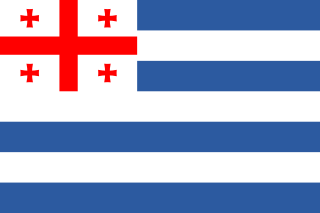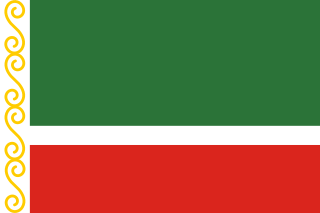 W
WThe flag of Adjara is a flag of Georgia's autonomous republic of Adjara. It displays seven dark blue and white stripes, with the national flag of Georgia shown in canton. The dark blue stripes symbolize the Black Sea and the white stripes symbolize purity. The flag was adopted on 20 July 2004 by the Supreme Council of Adjara.
 W
WThe current flag of the African Union was adopted at its 14th Ordinary Session of the Assembly of Heads of State and Government, which took place in Addis Ababa on 31 January 2010.
 W
WThe flag of Chechnya is a rectangle with sides in the ratio 2:3, the same ratio as the flag of the Russian Federation. The flag is composed of three horizontal bars of, from top to bottom: green, representing Islam; white; and red; superimposed on them is a narrow vertical white band at the hoist, containing the national ornament, a design of four golden scroll shapes. The horizontal bars are in the proportions 4:1:3.
 W
WThe flag of the Cocos (Keeling) Islands was created in 2003 and adopted on 6 April 2004. It was designed by territory resident Mohammed Minkom, who won a design contest as a teenager.
 W
WThe flag of Donetsk has two horizontal stripes with the shield of the city's coat of arms overlaid centrally.
 W
WThere are two flags in official use in the Serbian Autonomous Province of Vojvodina, the Flag of Vojvodina and the Traditional flag of Vojvodina. Two flags are given the equal status in the Provincial Assembly Decision on the Appearance and Usage of Symbols and Traditional Symbols of AP Vojvodina adopted in 2016.
 W
WThe flag of Georgia, also known as the Five Cross Flag, is one of the national symbols of Georgia. Originally a banner of the medieval Kingdom of Georgia, it was repopularized in the late 20th and early 21st centuries during the Georgian national revival.
 W
WThe flag of Iraq includes the three equal horizontal red, white, and black stripes of the Arab Liberation flag, with takbīr in Kufic script written in the center.
 W
WThe flag of Lithuania consists of a horizontal tricolor of yellow, green, and red. It was adopted on 25 April 1918 during Lithuania's first period of independence from 1918 to 1940, which ceased with the occupation first by Soviet Russia and Lithuania's annexation into the Soviet Union, and then by Germany (1941–1944). During the post-World War II Soviet occupation, from 1945 until 1989, the Soviet Lithuanian flag consisted first of a generic red Soviet flag with the name of the republic, then changed to the red flag with white and green bands at the bottom.
 W
WThe flag of Montenegro was officially adopted with the Law on the state symbols and the statehood day of Montenegro on 13 July 2004 at the proposal of the government of Montenegro. It was constitutionally sanctioned with the proclamation of the Constitution on 22 October 2007. It is a red banner with broader golden edges all around the red field with the coat of arms of Montenegro in its center.
 W
WOtago is one of the few regions of New Zealand to have officially adopted a flag.
 W
WThe Proposed Flag of North West England is an unofficial flag design which was created by graphic designer Peter Saville in 2004 following announcements by the British Government to put forward plans for the establishment of elected regional assemblies in England. The flag was supported by a pro-regionalist group, The Necessary Group which founded by Tony Wilson consisted of people who were in support of devolution in the North West.
 W
WThe flag of Sint Eustatius was adopted on 16 November 2004. The island's flag was designed by Zuwena Suares.
 W
WThe flag of the Székelys is the flag used by the Hungarian Székely community of Romania. It is a blue flag with a golden strip and a "sun-star" and crescent moon, both perceived as ancient Székely symbols. Being designed by Ádám Kónya, the Szekler National Council adopted it in 2004 and is since then a symbol for the Székely people. The Romanian authorities have imposed some restrictions on under which conditions may the flag be displayed, which has allegedly fostered its popularity.
 W
WThe flag of Umbria is one of the official symbols of the region of Umbria, Italy. The current flag was officially adopted on 18 March 2004, although the emblem and gonfalon had been in use since the 1970s. The Regional Law of 18 May 2004 officially confirmed the flag and added the words Regione Umbria in red, centered in the bottom fifth of the flag, but in common usage, the words are omitted.
 W
WThe flag of Yerevan shows Yerevan's arms surrounded by 12 triangles, symbolizing 12 past capitals of Armenia on a white background, symbolizing clearness and simplicity. The colors used in the flag are the same as in the flag of Armenia, representing the importance of Yerevan as capital.